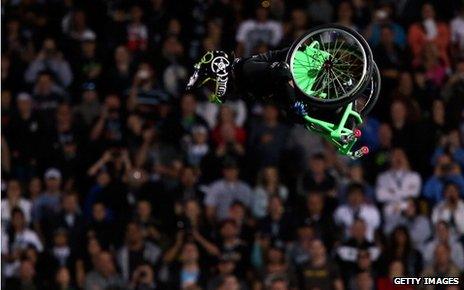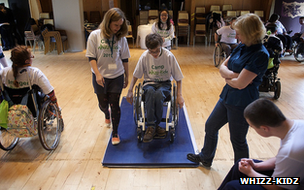How do wheelchairs get down stairs?
- Published
- comments
Pete Donnelly, wheelchair skills adviser for the charity Back Up, demonstrates how to make the most of your wheelchair
Using a wheelchair isn't always easy. Although some master advanced moves, most people just want to get safely from A to B - and that's when a wheelchair skills course can help.
Dilemma: You're in a wheelchair. You need to get to the other side of a road but there are no crossings and no "dropped" kerbs. It looks like you're in for a heavy bump down and a challenge to get back up again once you've crossed over. How do you do it?
"They teach you to do a little wheelie on to the road, and another little wheelie to get up the kerb on the opposite side," says Maisie McGarvey, 17, from Yorkshire, who benefited from wheelchair skills classes when she was younger.

Athlete Aaron Fotheringham performs extreme stunts in his wheelchair
Maisie contacted the charity Go Kids Go, external when she was 10. She wanted to be able to do sport but was not confident enough in her chair to do the fast moves or turns required. "They taught me to approach using a wheelchair in a positive way." They've been running since 1990 and count Paralympian and TV presenter Ade Adepitan as a former student.
The wheelies she describes are useful to master but can be quite challenging for some, so skills classes tend to start by concentrating on less risky moves.
For some, being independent means being able to push from kitchen to lounge while carrying cups of tea, to wheel up ramps or get back into the wheelchair after a fall. It doesn't have to be trial and error to learn these techniques - experienced wheelchair users run tutorial sessions to pass on their skills.
Pete Donnelly volunteers for spinal injury charity Back Up, external, where he teaches other paralysed people how to get the most from their chairs. He demonstrates several daily skills in the video above. "It's not about doing a lot of tricks," Pete cautions. "It's about doing what you need to do to get back to the life you want to live."
The Whizz-Kidz, external charity also run skills classes. It provides chairs for children but wants recipients to "know how to use them, to have fun and to be safe".
Magda has cerebral palsy and is a pupil at a special school in Croydon where Whizz-Kidz held a skills class. She recalls a slalom course so the children could practice weaving around obstacles on busy streets.
"We also learned how to get through a door without it hitting us," says Magda. "You have to push with one hand and hold the door with the other until you are through."
When out and about, Magda's mother used to wheel her, but now she feels confident pushing along the pavement on her own.
Shaun, 15, uses a manual wheelchair and has cerebral palsy. He wanted to travel to school with friends by public bus, rather than be collected by the school's own minibus. Trainers from Whizz-Kidz showed him strategies to achieve this.
The most obvious advice may well be the best. "They told me to make sure the driver can see me," says Shaun, "so I don't have to ask for the ramp."

Learning to negotiate ramps
The classes taught him to trust that his wheelchair's belt would hold him securely. He was then able to concentrate on getting up the ramp onto the bus with both hands pushing the wheels. He learned how to reverse into the bus's wheelchair space, which involved practicing small pushes to remain stable, learning how to stop at the right time and constantly checking what's happening behind him.
Shaun and Magda see wheelchair users every day at their special school but Maisie McGarvey has always been in mainstream education.
Her introduction to the wheelchair world was at a skills workshop. "I didn't even realise that there were other wheelchair users out there, let alone ones my age."
Having benefited from meeting other wheelchair users at these events, Maisie now helps out as much as she can with the charity that helped her when she was younger.
Tim Rushby-Smith was paralysed six years ago after falling from a tree. While in rehab, he was given advice on how to reach full potential with a chair by someone who had, like him, received a spinal cord injury.
He says his trainer talked in a straightforward way about everyday things such as "getting in and out of cars, meeting people and just getting on with things".
The newly disabled Tim was inspired by the experience. Now a proficient wheelchair user himself, Tim, like Maisie, also volunteers his skills and says: "I want to give something back."

Tim is keen to pass on the art of falling safely - or, more importantly, he likes to teach how to transfer from the ground back in to the chair.
"At the beginning, falling out of your wheelchair feels like falling off a cliff. The safest position to adopt when tipping out is to grab the chair's frame in front and tuck your chin into your chest.
"The most common injury is banging your head on the ground, so falling on rolled shoulders is better."
Tim has had his fair share of spills and has been surprised and distressed when passers-by have come over and attempted to pick him up by the legs to get him back on his wheels.
Some can fix it for themselves, others need to get help. "Knowing when and how to ask for support is part of the training too," says Tim.
You can follow Ouch on Twitter, external and on Facebook, external